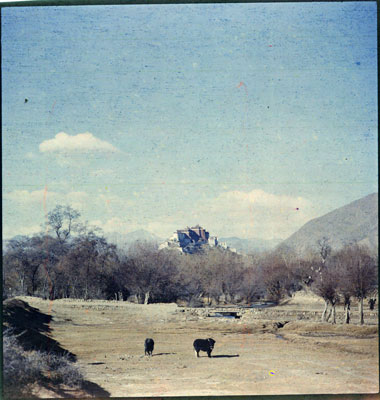
BMR.6.8.236 (Transparency colour)


BMR.6.8.236 (Transparency colour)

Hugh E. Richardson
Hugh Richardson
1936-50
Lhasa > Potala (from west)
BMR.6.8.236
60 x 90 mm
Transparency Colour
Hugh E. Richardson
Technical Information - The cameras used to take this collection of colour slides (Dufay colour) were a Zeiss Super Ikonta and a Reflex Korelle. [KC 09/10/2006]
Manual Catalogues - Typewritten handlist entitled 'Hugh Richardson Collection, The British Museum. Photographs taken between 1936-50. Cameras: Zeiss Super Ikonta, Reflex Korelle. 300 colour slides (Dufay colour); copies made Jan. 1995.
[no.] 236. Potala, seen from the west .' [KC 11/10/2006]
Other Information - Setting: The Potala Palace is the winter Palace of the Dalai Lamas and the seat of traditional Tibetan government. The palace is know as several names by the Tibetan, Tse Podrang, ( rtse pho brang ) or more formally, Potala Podrang ( pho brang po ta la ) The first structure was established by the legendary Tibetan Emperor Song Gampo on Mt Marpori in 637. The original structure is said to have been 11 stories high and was destroyed by lightening during the reign of Emperor Trisong Detsen. The present structure was built by the 5th Dalai Lama on the foundation of the earliest ruins. The Potala is divided into two parts, the central upper part is known as the Red Palace ( pho brang mar p o) and the surrounding structure is know as the White Palace ( pho brang dkar po ). The Red Palace contains the main temple inside the palace and housed the reliquaries of the successive Dalai Lamas. The Red Palace also represents the original structure build in the 7th Century. Between 1645-1653 the 5th Dalai Lama added the White Palace and made it the seat of his government. Since the 17th Century, the White Palace has formed the main administrative offices of the Tibetan government and it became the seat of Tibetan government only in the 18th Century when the 5th Dalai Lama shifted his base from Gaden Palace in Drepung monastery to the Potala. There are said to be over 1000 rooms and over 200,000 images inside. The grounds of the Potala also housed a school known as Tse Lobdra ( rtse slob grwa ) 'The Peak School'. The students were mostly boys from aristocratic families and trained to become government officials. The palace was also the site of two printing presses the older one known as Ganden Phuntsog Parkhang ( dpa’i ldan phun phyogs par khang ) founded in the 17th Century and in 1920s the 13th Dalai Lama established the Shol Printing House ( zhol par khang ). [TS 27/6/2005]
For Citation use:
The Tibet Album.
"Potala from the west"
05 Dec. 2006. The British Museum.
<http://tibet.prm.ox.ac.uk/photo_BMR.6.8.236.html>.
For more information about photographic usage or to order prints, please visit the The British Museum.
© The British Museum